Studies of peripheral sensory nerves in paclitaxel-induced painful peripheral neuropathy: evidence for mitochondrial dysfunction
- PMID: 16530964
- PMCID: PMC1805481
- DOI: 10.1016/j.pain.2006.01.037
Studies of peripheral sensory nerves in paclitaxel-induced painful peripheral neuropathy: evidence for mitochondrial dysfunction
Abstract
Paclitaxel chemotherapy frequently induces neuropathic pain during and often persisting after therapy. The mechanisms responsible for this pain are unknown. Using a rat model of paclitaxel-induced painful peripheral neuropathy, we have performed studies to search for peripheral nerve pathology. Paclitaxel-induced mechano-allodynia and mechano-hyperalgesia were evident after a short delay, peaked at day 27 and finally resolved on day 155. Paclitaxel- and vehicle-treated rats were perfused on days 7, 27 and 160. Portions of saphenous nerves were processed for electron microscopy. There was no evidence of paclitaxel-induced degeneration or regeneration as myelin structure was normal and the number/density of myelinated axons and C-fibres was unaltered by paclitaxel treatment at any time point. In addition, the prevalence of ATF3-positive dorsal root ganglia cells was normal in paclitaxel-treated animals. With one exception, at day 160 in myelinated axons, total microtubule densities were also unaffected by paclitaxel both in C-fibres and myelinated axons. C-fibres were significantly swollen following paclitaxel at days 7 and 27 compared to vehicle. The most striking finding was significant increases in the prevalence of atypical (swollen and vacuolated) mitochondria in both C-fibres (1.6- to 2.3-fold) and myelinated axons (2.4- to 2.6-fold) of paclitaxel-treated nerves at days 7 and 27. Comparable to the pain behaviour, these mitochondrial changes had resolved by day 160. Our data do not support a causal role for axonal degeneration or dysfunction of axonal microtubules in paclitaxel-induced pain. Instead, our data suggest that a paclitaxel-induced abnormality in axonal mitochondria of sensory nerves contributes to paclitaxel-induced pain.
Figures
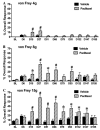

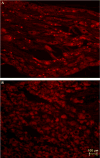

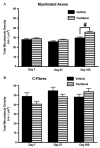

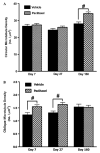
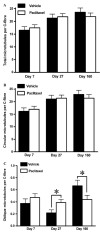


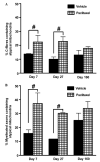
Similar articles
-
Dynamic long-term microstructural and ultrastructural alterations in sensory nerves of rats of paclitaxel-induced neuropathic pain.Chin Med J (Engl). 2014;127(16):2945-52. Chin Med J (Engl). 2014. PMID: 25131233
-
Mitochondrial abnormality in sensory, but not motor, axons in paclitaxel-evoked painful peripheral neuropathy in the rat.Neuroscience. 2011 Dec 29;199:461-9. doi: 10.1016/j.neuroscience.2011.10.010. Epub 2011 Oct 19. Neuroscience. 2011. PMID: 22037390 Free PMC article.
-
Microtubule disorientation and axonal swelling in unmyelinated sensory axons during vincristine-induced painful neuropathy in rat.J Comp Neurol. 1998 Jun 15;395(4):481-92. J Comp Neurol. 1998. PMID: 9619501
-
Chemotherapy-induced peripheral neuropathy.Curr Neurol Neurosci Rep. 2008 Jan;8(1):56-65. doi: 10.1007/s11910-008-0010-5. Curr Neurol Neurosci Rep. 2008. PMID: 18367040 Review.
-
Pathogenesis of paclitaxel-induced peripheral neuropathy: A current review of in vitro and in vivo findings using rodent and human model systems.Exp Neurol. 2020 Feb;324:113121. doi: 10.1016/j.expneurol.2019.113121. Epub 2019 Nov 21. Exp Neurol. 2020. PMID: 31758983 Free PMC article. Review.
Cited by
-
Basic science and clinical management of painful and non-painful chemotherapy-related neuropathy.Gynecol Oncol. 2015 Mar;136(3):453-9. doi: 10.1016/j.ygyno.2015.01.524. Epub 2015 Jan 10. Gynecol Oncol. 2015. PMID: 25584767 Free PMC article. Review.
-
Paclitaxel causes degeneration of both central and peripheral axon branches of dorsal root ganglia in mice.BMC Neurosci. 2016 Jul 11;17(1):47. doi: 10.1186/s12868-016-0285-4. BMC Neurosci. 2016. PMID: 27401104 Free PMC article.
-
Wen-Luo-Tong Decoction Attenuates Paclitaxel-Induced Peripheral Neuropathy by Regulating Linoleic Acid and Glycerophospholipid Metabolism Pathways.Front Pharmacol. 2018 Aug 28;9:956. doi: 10.3389/fphar.2018.00956. eCollection 2018. Front Pharmacol. 2018. PMID: 30233366 Free PMC article.
-
Divergent effects of painful nerve injury on mitochondrial Ca(2+) buffering in axotomized and adjacent sensory neurons.Brain Res. 2014 Nov 17;1589:112-25. doi: 10.1016/j.brainres.2014.09.040. Epub 2014 Sep 22. Brain Res. 2014. PMID: 25251590 Free PMC article.
-
The development and maintenance of paclitaxel-induced neuropathic pain require activation of the sphingosine 1-phosphate receptor subtype 1.J Biol Chem. 2014 Jul 25;289(30):21082-97. doi: 10.1074/jbc.M114.569574. J Biol Chem. 2014. PMID: 24876379 Free PMC article.
References
-
- Andre N, Braguer D, Brasseur G, Goncalves A, Lemesle-Meunier D, Guise S, et al. Paclitaxel induces release of cytochrome c from mitochondria isolated from human neuroblastoma cells. Cancer Res. 2000;60:5349–53. - PubMed
-
- Authier N, Gillet JP, Fialip J, Eschalier A, Coudore F. Description of a short-term Taxol-induced nociceptive neuropathy in rats. Brain Res. 2000;887:239–49. - PubMed
-
- Brewer PA, Lynch K. Stimulation-associated changes in frog neuro-muscular junctions. A quantitative ultrastructural comparison of rapid-frozen, chemically fixed nerve terminals. Neuroscience. 1986;17:881–95. - PubMed
-
- Campana WM, Eskeland N, Calcutt NA, Misasi R, Myers RR, O’Brien JS. Prosaptide prevents paclitaxel neurotoxicity. Neurotoxicology. 1998;19:237–44. - PubMed
-
- Carre M, Andre N, Carles G, Borghi H, Brichese L, Briand C, et al. Tubulin is an inherent component of mitochondrial membranes that interacts with the voltage-dependent anion channel. J Biol Chem. 2002;277:33664–9. - PubMed
Publication types
MeSH terms
Substances
Grants and funding
LinkOut - more resources
Full Text Sources
Other Literature Sources
Medical
Miscellaneous

